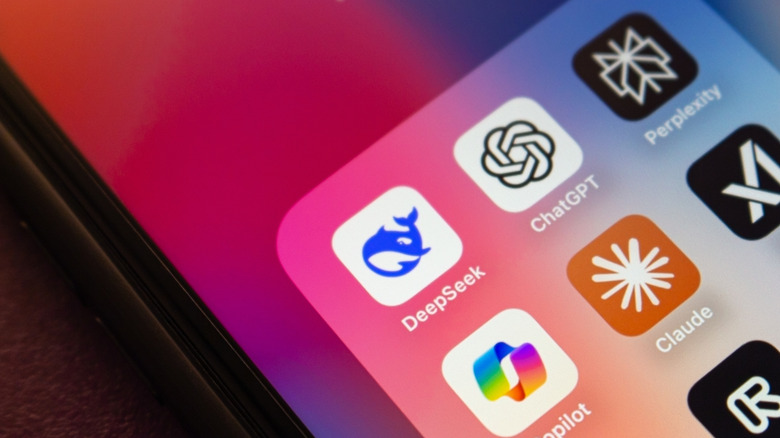5 Reasons Why You Should Run An AI Chatbot Locally On Your iPhone
Your latest iPhone isn't just for taking crisp selfies, cinematic videos, or gaming; you can run your own AI chatbot locally on it, for a fraction of what you're paying for ChatGPT Plus and other AI subscriptions. Apple claims its A-series chips on the latest iPhones deliver "MacBook Pro levels of AI compute." With such powerful chips, you can run compressed small language AI models, which are squeezed into apps entirely on your phone.
You don't need expensive infrastructure to run a local AI model on your phone: All you need is the latest iPhone model, preferably with an A18 or A19 Pro chip, and an app that supports multiple compressed local AI models. Once you install an app, download a small language model suitable for your tasks, and enable offline mode to test its performance on your device.
Why run an AI chatbot locally when you can use ChatGPT, Claude, Gemini, and other apps? Premium AI subscriptions cost around $20 per month, and even with these subscriptions, users can face hallucination issues, server outages, and response lag. Moreover, prompt limits, privacy concerns, and internet connectivity, make cloud AI difficult to use for some. From saving subscription money to customizing a small language model for specific tasks, here's why you should run an AI model locally on your iPhone.
No response lag
Local AI chatbots respond quickly to your queries with minimal lag. Cloud AI chatbots like ChatGPT start "thinking" as soon as they receive your query, and take a few seconds to respond. The request travels to remote servers, then the large language models take time to process your prompt to generate a response. Each step adds latency depending on server load and network conditions.
Local AI chatbots process requests instantly on-device to offer real-time responses because they don't require any server or Wi-Fi connection. Your iPhone's processor handles your requests with reliable speed. There are also no outages due to server load or network congestion delays. On recent iPhones, especially with A16 and A17 chips, compressed lightweight models like Phi-3-mini (3.8 billion parameters) generate text at 10-15 tokens per second, while smaller models can exceed 20 tokens per second.
You can run smaller models such as the Phi-3-mini even on iPhone 13, but mid-sized and larger models (up to 13 billion parameters) requires iPhone 15 or newer devices.
Slash your spending
Premium AI subscriptions like Claude Pro, Google Gemini Pro, and Perplexity Pro cost about $20 a month. If you have multiple subscriptions, you could spend around $500 annually. You can cut this cost with a local AI model: In most cases, local AI chatbot apps charge a one-time fee, which is usually around $10-$20, depending on the app and the model. That means no recurring charges, no prompt limits, and no tiered subscriptions. A local AI app like Private LLM costs $4.99 once, which is far cheaper than a single month of ChatGPT Plus subscription.
The only catch here is that local AI models are not as capable as some large cloud systems like GPT-4, GPT-5, or Claude Sonnet 4.5. Local AI models are trained on limited data and may not offer complex reasoning like ChatGPT and Gemini. However, you can use them for regular tasks such as writing emails, summarizing articles, and brainstorming ideas. Some local AI models, like Qwen 2.5 (7.6 billion parameters) and Mistral (7.3 billion parameters), punch well above their size class, and can deliver quality on par with some recent cloud services.
Better for privacy
When you use ChatGPT, Claude, or Gemini, they store all the data, either temporarily or permanently, in their servers and data centers to further train their chatbots and other purposes. It's up to a company's privacy policies on how this data is used. These policies often change, and in most cases, users don't even read them. That's why some countries have blocked ChatGPT over data concerns.
This isn't the case with local AI chatbots. These language models process everything on-device using Apple's Neural Engine, store chat history in your iPhone's encrypted storage, and don't share data with an external server. Your data stays safe on your device. Some apps like Private LLM and LLM Farm are designed for zero cloud involvement. They don't collect analytics or require accounts and all your interactions are stored on your phone. Private LLM has a simple setup with small, efficient models and quick prompts while LLM Farm adds features like offline model switching and privacy controls.
Works offline
Cloud AI chatbots can be impressive, but you need to have a stable internet connection to use them. They rely on remote servers to process your prompts, which means network latency or outages can affect your workflow. Local AI chatbots are designed to work entirely offline. The only time you need an internet connection is while downloading the app and the specific language models you wish to use.
These models can range from several hundred megabytes to several gigabytes in size. The model runs on your iPhone, processes queries on the device, and requires no cellular data. The whole model lives in your storage, so responses don't depend on server load or signal strength. Apps like Ollama and LLM Farm even let you switch between models offline. You can pick smaller models for quick queries, and switch to larger ones for better reasoning. This is ideal for those who often travel for work or stay in remote areas.
Customize your AI experience
Cloud chatbots like ChatGPT, Gemini, and Claude generally give you one model tuned to one set of guidelines. These generic models can make responses less useful for your specific tasks. With local AI apps, you can choose an AI model ideal for a specific tasks. Apps such as Llama, Qwen, Phi, and Mistral let you download models optimized for speed, accuracy, or specific niche.
You can experiment with interface themes, privacy settings, and even context window size to match your workflow. Apps like LLM Farm even support custom model imports. This allows you to use your own specific data to set the context and improve the model's accuracy for tasks like coding and analysis.
This is useful for professionals with specific workflows and allows them to create a more personalized AI setup on their device without relying on third-party cloud services. This way, users get full control over the model's deployment, configurations, and updates.





